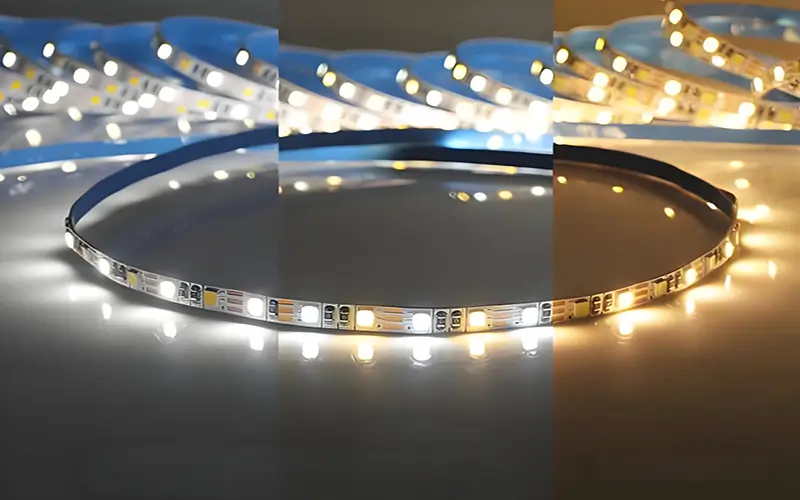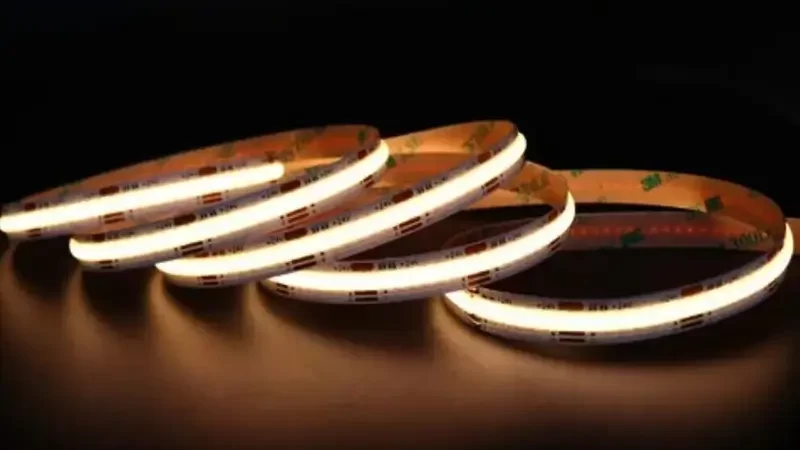
LED strip lights are now the new favorite for indoor and outdoor lighting. Their main advantages are energy saving, long life and diversified color control functions. However, many users will find during installation or use that the luminous colors of some parts of the LED light strips used in the same project look inconsistent. Why is this? This article will systematically answer the reasons for the different colors of my LED strip lights, possible problems, and how to avoid such situations.
Why Do Some LED Strip Lights Colors Sometimes Look Different?
Although you may have purchased the “same model” of LED strips, in actual use, if you look closely or observe in a specific lighting environment, you will find that the color temperature of some areas is cooler or warmer, or even different in color intensity.
Common reasons for color inconsistency are as follows:
- The color at the beginning and end of the same strip is different, and the color at the end is not as pure as the front.
- Sometimes, the strip will show different colors along its length, creating a rainbow-like effect.
- Two strips used in the same space have different colors, especially at the splicing or corner areas.
- After turning on the lights in different areas, the naked eye can feel the difference in coldness and warmth.
- Another difference is the difference that the naked eye knows, which may also be the result of the quality of the LED itself or the way it is used.
Is it Accurate to Say that the LED Strip Lights have Inconsistent Colors?
In the LED industry, all manufacturers classify LED light sources according to “bins”. A bin usually represents a narrow range of color temperature, brightness, and voltage, and machine testing ensures product consistency.
The following are the situations where the colors look different:

The human eye is extremely sensitive to color temperature
Different people have different sensitivities to color. Some people can detect color temperature differences as small as tens of K. Others think the difference is not significant. When compared side by side, even the same bin may show a difference.
The installation environment affects color perception
Different reflective surfaces, background colors, wall materials, etc., will change the final “presented” light effect. Only a white backplane can show the difference.
The aging time of the light strip is different
A newly installed light strip and an LED light strip that has been used for several months may produce visual differences even if the factory data is the same.
Driving voltage or current fluctuations
If it is a long LED light strip, the power supply voltage at both ends of the light strip is different, which will cause light decay or color change at the end.
Therefore, even if the test data is consistent, the actual use environment and naked-eye perception may still cause “looks different” situations.
Why Do LED Strip Lights Have Different Colors?
As far as the quality of current LED strips is concerned, such problems rarely occur. But if the LED strips you buy now have such problems, you can refer to the following reasons.
LEDs bead problems
To save costs, low-end strips may use LEDs that are not strictly binned, resulting in inconsistent color temperature and brightness distribution per meter of LED strips.
PCB quality problems
Poor PCB heat dissipation, unqualified chip packaging technology, etc., all of which can also cause color differences and brightness differences.
Mixing of different batches
Even products of the same brand and model may have slight differences in different production batches; it may be that mixed installation is a common cause of color differences.
The light strip is too long or the voltage drops
When the light strip exceeds a certain length (such as 5 meters), if there is no double-end power supply, the brightness at the end will dim and the color temperature will deviate due to the voltage drop.
Insufficient power supply
Insufficient power and incompatibility of the power supply will affect the color temperature of the LED light strip, causing the colors at the beginning and end to look different. Another point is that if different models of power supply are used, it may also affect the color temperature performance.
Aging of the LED strip or different use times
As the use time of LED lamp beads increases, a certain degree of light decay will occur; therefore, the color of the LED light strip will also be different when it is used for different times.
Difference in installation method or background material
The light reflected by the white wall is different from that reflected by the dark wooden board. If you install the LED light strip into the LED profile, the depth of the light trough, the material of the diffuse reflector, etc. will affect the visual output of the light.
How to Avoid Different Colors of Your LED Strip?
When you purchase LED strips, you need to pay attention to the following details. Here are some practical suggestions to greatly reduce the inconsistency of strip colors:
Require “same bin classification” when purchasing
Explicitly require manufacturers to provide products with the same color temperature BIN, and each order must maintain a BIN of lamp beads.
Confirm unified testing before installation
Light up all strips at the same time before installation for “real scene testing”; if you find color difference, you need to adjust and match in time to avoid rework.
Do not mix different batches or brands
It is best to keep the strip packaging label and batch number each time you place an order to avoid mixing during later maintenance. Also, try to purchase the required length at one time, and do not place orders in multiple times.
Reasonable wiring to avoid a voltage drop
For installation sections exceeding 5 meters, it is recommended to supply power at both ends. This can reduce the impact of voltage drop and prevent inconsistent colors at the beginning and end.
Keep the installation environment consistent
Try to use the same type of light trough, reflective material and light diffusion board in the same space. This can avoid the difference of products in the same space.
Conclusion
Although the colors difference problem of LED strip lights is common, it can be avoided now. The key is: from the source of purchase to the details of installation, every link must be carefully controlled. As long as you choose the right product, unify the batch, pay attention to the wiring and driver matching, you can make your light strip effect more consistent, professional and beautiful.
We are a manufacturer of LED tape lights, producing a Bin color temperature light strip, keeping the color temperature and color consistent, without any color difference.
FAQs
This is usually caused by voltage drop across the strip, especially if the strip is longer than 5 meters. The farther away from the power source, the dimmer or more different the color may be.
The power of different power supplies will affect the color of the LED strip. If you use a power supply with incorrect voltage or unstable output, it may cause color distortion or flickering.
Absolutely. Cheap LED strips often ignore strict quality control and color temperature is not so fine. This leads to mixed color temperature, poor RGB mixing, and reduced durability.
Yes. Over time, the aging of the phosphor of the white LED or the uneven aging of the chip of the RGB strip can cause the color to fade or shift.
